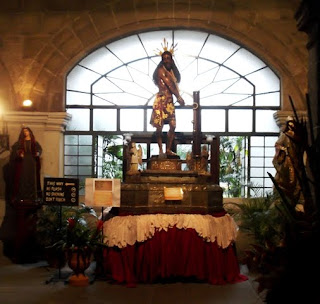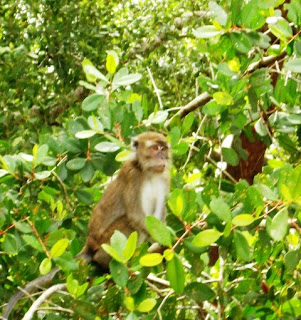The route from Manila, Philippines to Hong Kong, China was almost straight north until we passed the north end of Luzon Island then east to China across the South China Sea. We confirmed again that the South China Sea really is green. The journey took only a day and a half but it was rainy and rough. It seems that I bragged too soon about not feeling seasick on this trip. I spent most of Saturday, February 23 seated by the potted orchids in the reception area, the exact center of the ship where there was the least motion. I was not ill but I was uncomfortable. The ship was crossing twenty-five foot swells diagonally so there was a lot of up and down plus some rolling side to side. The stabilizers work well to minimize roll but these conditions were challenging for them. I was accustomed to the up and down but the side to side got to me. Sitting by the orchids, I was able to read and to observe the comings and goings of passengers and crew. After a day and a half of discomfort, I was more than ready to head home when we reached Hong Kong.
One of the great sights of this trip was sailing into Victoria Harbour. Three years ago we sailed in early in the morning on an overcast and misty day. I saw only the bottom few stories of the famed high-rise buildings. Everything above sixty feet or so was shrouded by fog. On that trip we were in the city only long enough to transfer to the airport so I really saw almost nothing of Hong Kong.
This time the Silver Whisper arrived around noon. The sky was hazy but we could see the sky line clearly. Tall buildings appeared through a light haze, which diminished as the day wore on. Many kinds of boats and ships plied the harbor waters or were anchored in the bay. We came slowly to our dock at the passenger terminal in Kowloon and had a great view of the not quite completed fourth tallest building in Asia. China has such terrible air pollution that it is usually hazy. This day the haze was not severe and I could clearly see the antennae on top of Victoria Peak, the highest point on Hong Kong Island.
Michael and I had the afternoon to explore the city. We were scheduled to leave for the airport early the following morning but we would have the afternoon ashore and one last night aboard ship.
Michael has visited Hong Kong six or seven times and had an idea of the sights he wanted to show me. We were off the ship almost as soon as it had cleared customs and made our way to the adjacent ferry terminal. Riding the Star Ferry is both cheap and efficient. We brought Hong Kong dollars so were able to purchase ferry tickets from a machine for about 60 cents U.S. each. The pedestrian route into Hong Kong Island from the Central Star Ferry Pier took us on walkways over a number of streets and through buildings. The walkway ended near the HSBC bank. It was startling to see double-decker trams running the "wrong" way down the major streets. (Hong Kong was once British: they drive on the left.) We made our way past steel and glass office buildings climbing uphill to the entrance to the Peak Tram. Victoria Peak is a must-see attraction and the Peak Tram is the way most tourists and locals too, get there. We joined a long line of mostly Chinese-speaking people waiting for the tram; as it was Sunday, it took us half an hour to board. Locals as well as tourists (we met a young couple from central China) were crowding into the tram station to ride up the mountain to the viewing area on the top.
The tram station at the top of Victoria Peak is located in an unusual T-shaped building that has three floors of shopping mall and a viewing deck on top. We did not pay extra to visit the viewing deck, as there are walking paths all around the area that provide many good spots for viewing the city and harbor below. One thing we realized: the Chinese do not mark the exits or in any way nor indicate which way to go. They appear to want to maximize potential customers' exposure to purchasing opportunities while they are seeking a way out. We found this to be true also at the cruise terminal on our return to the ship. We had to go through a giant shopping mall there – it seemed larger than the one in Manila – to find the entrance to the pier. No signs there either.
Some of the most interesting things we saw on our way back to the ferry were large numbers of young Filipinas gathered in small groups on the elevated walkways and in downtown parks, chatting and visiting with one another. Michael told me that they are maids and nannies to well off Chinese employers. They have a tradition of visiting with each other on their Sunday afternoons off. Speaking the clipped sounding Tagalog, they sounded like a flock of sparrows. We also viewed a wedding party in Hong Kong Park. The bride was dressed in auspicious bright red and held a bouquet of red roses. Except for the color of the bride's dress, they looked like any Western wedding party.
We walked around for a while on Hong Kong Island and then returned by Star Ferry to Kowloon where we walked some more along the waterfront and through the famous Nathan Road shopping district until dusk. In Kowloon we came upon a park decked out for Chinese New Year. It was the final night of the weeklong celebration. Back aboard ship we saw the best sight of all. We watched the harbor side buildings light up as the light faded. Many Hong Kong office buildings light up bizarrely each evening. At 8 PM when it was fully dark, everyone near the harbor was treated to Hong Kong's nightly laser light show where brilliant laser beams flash between buildings and across the harbor. Before, during and after the laser show many large buildings provide moving lighted displays. Some buildings change colors, some have moving graphics, or strings of LEDs that progressively light up giving the impression of moving lines or bands of light. The display continued to eleven PM. The Silver Whisper had docked portside to the pier so we were able to watch the show from our starboard veranda. For Michael and me, having a Port wine and watching the show was a great way to end our 50-day cruise.
The taxi ride to the airport the following morning was uneventful, even somewhat anti-climactic. I had been in the terminal before; everything seemed familiar. I forgot to take my nail scissors out of my carry on and the Chinese security guards, after a lengthy conference, confiscated them. I must look like a terrorist. I don't know what damage I could do with two inch blunt tipped blades but I must appear dangerous to the Chinese. It does seem that airport security worldwide chooses me for extra scrutiny far more often than Michael. The word must be out that little old ladies like me are prime suspects for being up to no good.
Our flight back to the U.S. on United's international First Class was something of a disappointment. The video system did not work properly, the food was bland compared to that we had on Silversea, and the service was borderline rude. The time Michael and I flew back from Shanghai in business class was better. I probably should not complain, after all I will be unlikely to fly international first class again. We flew first class this time because it was available for not too many miles more than business class. I believe that most of the other first class passengers were not full fare paying customers either. No one paying thousands of dollars extra for a first class seat would put up with the poor service.
Grumbles aside, this was a most amazing trip. I saw parts of the world I had never seen before. We met interesting people and had unusual adventures. The ship took care of us wonderfully. I'm glad to be home again but I am starting to look forward to our next cruise this coming summer. This will be on the newly refurbished less than 300 passenger Silver Cloud traveling from Southampton, England to Copenhagen and from Copenhagen along the coast of Norway to Arctic Russia and back. It will be a very different experience and very photogenic. I do hope you have enjoyed this account of my travels.





























































